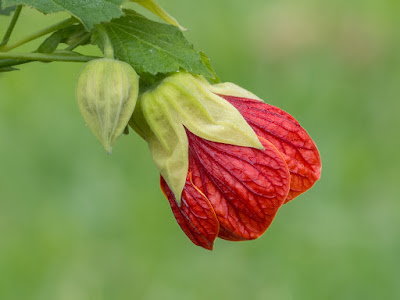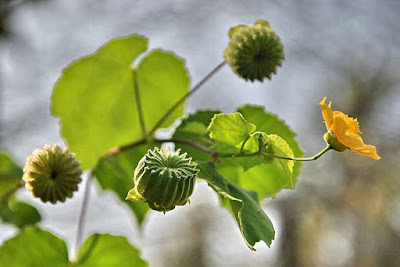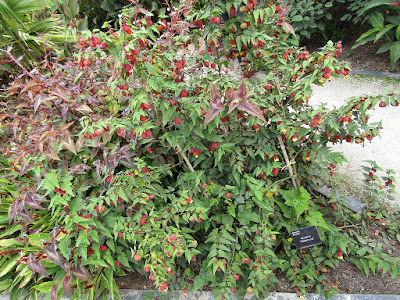Abutilon is distributed throughout the tropics and subtropics of the Americas, Africa, Asia, and Australia. It is found in the torrid and temperate zones.
Abutilon also called as Indian mallow, Velvetleaf, Room maple, Parlor maple, Flowering maple, Abortopetalum, is a genus of the Malvaceae family. This genus was described by Philip Miller in 1754.
IDENTIFY ABUTILON PLANT
Abutilon is distributed throughout the tropics and subtropics of the Americas, Africa, Asia, and Australia. It is found in the torrid and temperate zones.
Indian mallow are herbs, shrubs, or trees which reaching about 1 to 10 meters in height with entire (occasional lobed), palmately veined and have wavy or serrated edges, up to 10 cm long leaves. The herbage is generally hairy to woolly or bristly.
Velvetleaf bloom from April to December (depending on the species) with solitary, paired flowers or borne from the small inflorescences in the leaf axils or toward the branch tips. The flowers of wild species are most often yellow or orange, but can be red or pinkish, sometimes with a darker center. . The fruit is a rounded or hemispherical schizocarp with up to 20 segments, each containing a few seeds.
There are garden forms and varieties with white and variegated leaves and white, red and yellow bright flowers, with numerous stamens that adorn them. In culture there are only a few species. From them are obtained decorative varieties and hybrids. Hybrid forms are characterized by a longer flowering period, various color and shape of flowers and leaves.
Abutilon is used for gardening rooms, winter gardens, large premises. By selecting different types and varieties, it is possible to obtain compositions with continuous flowering only from abutilons. Unusual varieties can be obtained by vaccination with variegated forms on plant species with green leaves.
The most common plant of this genus are: Abutilon hybridum (Abutilon pictum x Abutilon darwinii with white, golden, red, burgundy flowers); Abutilon sellowianum (light purple flowers with pink veins); Abutilon vitifolium (lavender-blue, sometimes with dark veins petals); Abutilon pictum (golden-yellow, decorated with reddish streaks flowers); Abutilon megapotmicum (light yellow petals with a red spot at the base).
ABUTILON PLANT CARE AND CULTURE
Cultural information should only be used as a guide, and should be to be adapted to suit you. Your physical location; where you grow your plants, how much time you have to devote to their care, and many other factors, will need to be taken into account. Only then can you decide on the cultural methods that best suit you and your plants.
Light:
Abutilon is a rather unpretentious plant, and it is not difficult to grow it even for beginners of indoor flower growing. It can be grown in a bright place or a slightly darkened place. For several hours a day, it need direct sunlight. In summer, the plant can be taken outdoor, but it should be positioned so that it is protected from wind and rain. A dramatic change in lighting, rain and wind can cause leaves and flowers to fall. In winter, with a lack of light, it is desirable to use fluorescent lamps.
Temperature:
In summer, the optimum temperature is between 22-25 ℃. In winter, the air temperature is lowered to 12-15 ℃. With a sharper temperature drop, the plant can shed its leaves.
Substrate and growing media:
Abutilon need a well-drained soil. The recommended substrate is with a neutral or slightly acid reaction (pH about 6), consisting of equal parts of turf, leaf and humus soil with the addition of sand. In some sources, a new pot should not be much more spacious than the previous one. They can also be grown hydroponically. Transplanted in the spring, but not during flowering. Young plant should replant every year, adult plants every 2-3 years.
Watering:
From the beginning of spring to autumn, Indian mallow need abundantly water and spray in hot waether. In winter, watering is reduced, making sure that the soil does not dry out completely, as needed spray the plant.
Fertilizer:
From spring to autumn, this plant need fertilizer every two weeks with mineral and organic fertilizers.
Rest period:
Depending on the type and flowering, the plant may need a rest period in winter with the temperature of 10-15 ° C watering is moderate, the plants are sprayed, not fed.
Pruning:
Abutilon grows very fast and, under favorable conditions, gives a great increase over the spring-summer season. In order for the plant to have a more magnificent crown, at the end of winter and early spring it is cut to half the height of the shoots. During the growing season, it is necessary to carry out a cleansing pruning from weak and thickening shoots.
Propagation:
Abutilon is propagated by seeds and half-lignified cuttings. Seeds reproduce non-variegated forms of abutilon, since in seed reproduction there is a splitting of parental traits. Seeds are sown in early spring (March-April), in a light substrate (sand + peat or others) at a depth not lower than 6 mm. Maintain the temperature in the range of 16-20 ° C, constantly sprayed aired. Shoots appear on day 20. Seedlings with good care can start in the same year.
When abutilon propagates by apical stem cuttings, cuttings are used from the ends of young shoots or shoots remaining after pruning. The cuttings are cut 10–12 cm long with three leaves, the buds are plucked out. Rooted cuttings in the spring, in a wet loose substrate (sand + peat or other) or in water at a temperature of 20-22 ° C. It is necessary to maintain humidity and constantly air, the greenhouse is best suited for this purpose. Rooting occurs within 4 weeks. When the seedlings take root, they can be planted into pots with a diameter of 7 cm.















COMMENTS